Portulacaria longipedunculata
Portulacaria longipedunculata (Merxm. & Podlech) Bruyns & Klak (= Ceraria longipedunculata Merxm. & Podlech)
Family: Didiereaceae
Common names: Kaoko porkbush (Eng.), langblaarwolftoon (Afr.)
Introduction
Portulacaria longipedunculata is an ascending, slow-growing shrub with reddish to pale brown peeling bark and scar-like nodes from which small, linear to club-shaped, olive green, rounded, succulent leaves grow. Very small pink flowers grow in short racemes in winter to spring. It grows widespread in the northern Namib Desert in Damaraland and the Kaokoveld in northwestern Namibia as well as in southwestern Angola. Best for desert gardens.
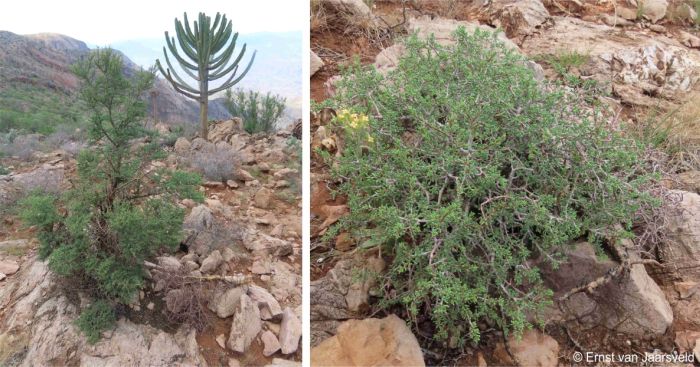
Fig. 1. Portulacaria longipedunculata growing on Middelberg Peak, at the southern end of the northern Kaokoveld, on dolomite; left a mature plant growing near a fine specimen of Euphorbia eduardoi and right, a young plant growing beside a flowering specimen of Kalanchoe lanceolata.
Description
Description
Slow growing much branched succulent leaved evergreen shrub to 2-3 m tall with a rounded to spreading crown. The roots are succulent, bearing brownish maroon bark when exposed. Juvenile plants with spreading stems. Mature plants usually with a solitary main stem on which the leathery brownish yellow bark is peeling. Younger branches are reddish to pale brown, becoming greyish and with reduced spur branches from where groups of leaves and peduncles appear. The green to olive-green leaves are spirally arranged, subsessile to shortly petiolate, 7-20 x 2-2.5 mm, spreading, cylindrical to club-shaped, in groups of three to four on shorter side twigs. The younger plants have club-shaped leaves becoming terete in mature specimens. The leaf tips are blunt (obtuse). The flowers are produced in axillary racemes, short, to about 20 mm long, appearing from the spur branches among the leaves, each bearing up to 7 flowers. Flowers with spreading pink petals and shortened bract-like calyces. The petals 5, oblong with blunt (obtuse) tips, becoming reflexed. The stamens arising from the petal base, slightly shorter than petals. The seed is a nutlet. Flowering time is in winter to spring (August-October). Seeds are dispersed in summer. (January-March), southern Hemisphere.
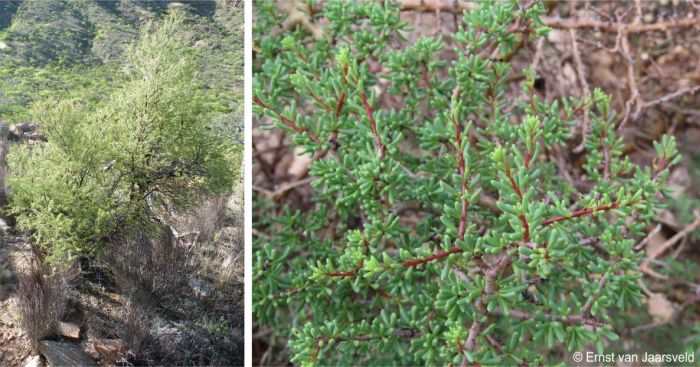
Fig. 2. Portulacaria longipedunculata growing at Iona Peak in the Iona National Park, southwestern Angola; left a mature specimen growing among sandstone rocks and right, a close-up of the leaves showing the reddish stems of the current year’s growth and the light greyish mature bark on the older growth.
Conservation Status
Status
Plants are widespread and not threatened.
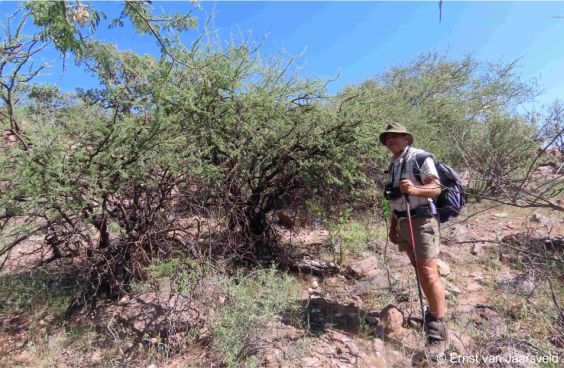
Fig. 3. Wessel Swanepoel standing among a group of Portulacaria longipedunculata growing on sandstone-derived soil, on the upper slopes of Sierra Chamalinde in southwestern Angola.
Distribution and habitat
Distribution description
Portulacaria longipedunculata is only known from the northern Namib Desert, growing both in northwestern Namibia from Sesfontein District in the south. to southwestern Angola. It grows on various geological formations such as dolomite, sandstone, or granite. Plants grow in Desert and dry Savanna at altitude of between 500 and 2 000 m.
Near Caranculo in southwestern Angola plants were observed on granite hills growing on a western slope. They share their habitat with other succulents such as Commiphora discolor, Commiphora wildii, Kleinia longiflora, Euphorbia gracilicaulis, Euphorbia mauritanica and Talinum caffrum. At Iona Peak in the Iona National Park, southwestern Angola, plants grow in arid mountain savanna on sandstone, among plants such as Adenia repanda, Euphorbia eduardoi, Euphorbia guerichiana, Euphorbia otjingandu, Senegalia montis-usti, Sterculia africana, Sterculia quinqueloba, Commiphora discolor, Cyphostemma currorii, Turnera oculata var. paucipilosa, Strophanthus amboensis and Kleinia longiflora. At Middelberg, northern Kaokoveld in northwesterm Namibia, plants were observed growing on the mountain peak among dolomite and quartzitic sandstone with Aloe hereroensis, Cussonia angolensis, Ficus cordata, Euphorbia otjingandu, Huernia urceolata, Tinospora fragosa, Obetia carruthersiana, Portulacaria carrissoana and Sansevieria pearsonii.
Rainfall is sparse, the region receives between 50 and about 100 mm per annum, during spring and autumn. The summers are very hot, temperatures often over 40°C in summer. Winters are warm during the day and nights are cooler and without frost.
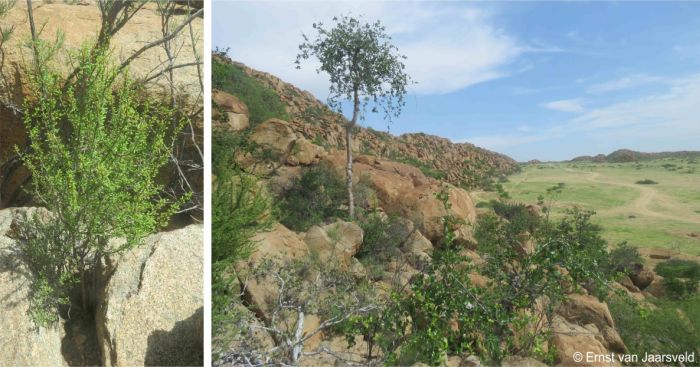
Fig. 4. Portulacaria longipedunculata growing among granite rocks in the Namib Desert, on the exposed western slope of a granite hill a few km west of Caranculo, southwestern Angola; the tall shrub is Commiphora discolor.
Derivation of name and historical aspects
History
Portulacaria longipedunculata was first named in 1961 as Ceraria longipedunculata by the German botanists, Hermann Merxmuller (1920-1988) and Dietrich Podlech (1931-2021) in the journal Mitteilungen der Botanischen Staatssammlung Munchen. The plants were discovered by Bernard de Winter and Otto Leistner on their expedition to Kaokoveld, just north of Warmbad in 1957 (Leistner 2022). This species, and all others in the genus Ceraria, were transferred to the genus Portulacaria in the Taxon botanical magazine by Peter Bruyns and other botanists in 2014.
Portulacaria longipedunculata most closely resembles Portulacaria namaquensis from the lower Orange River in the Northern Cape and southwestern Namibia. However P. namaquensis is generally a larger plant, and has smaller club-shaped leaves and the stems with distinctive and conspicuous regular highly reduced spur branches from which groups of leaves and peduncles appear.
The species name longipedunculata, meaning ‘with long peduncles’, pertains to the stalk bearing the flower or fruit of Portulacaria longipedunculata.
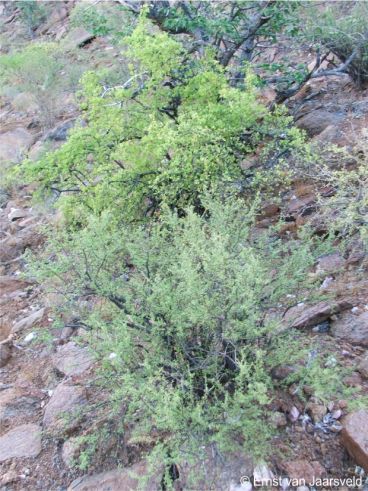
Fig. 5. A mature specimen of Portulacaria longipedunculata growing on weathered granite on the lower western slope of the Otjihipa Mountain, Kaokoveld, northwestern Namibia. The plant behind it is Portulacaria carrissoana.
Ecology
Ecology
Portulacaria longipedunculata is desert-adapted and can withstand very dry, hot conditions and prolonged droughts. Moisture is stored in its linear, terete to club-shaped, succulent leaves and roots. The young stems are reddish due to anthocyanin pigments protecting the young stems from harmful sunrays. The leathery, light coloured, greyish, reflective bark, often peeling in horizontal strips, protects it from the sun. The growth of P. longipedunculata is slow and conservative. The flowers are pollinated by small insects. The winged fruits are dispersed by wind.
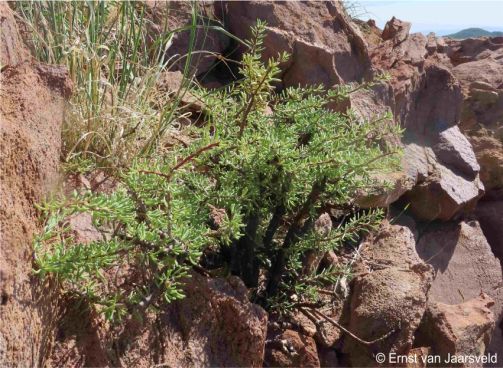
Fig. 6. A young plant of Portulacaria longipedunculata growing among sandstone rocks on the upper slopes of Sierra Chamalinde, southwestern Angola. Note the young reddish stems which mature to a light greyish reflective bark, and the older dark main stems.
Uses
Use
No medicinal or cultural uses are recorded.
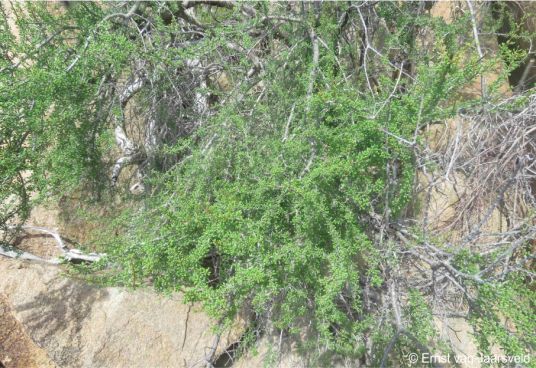
Fig. 7. A mature plant of Portulacaria longipedunculata growing among granite rocks on the exposed western slope of a granite hill a few km west of Caranculo, southwestern Angola.
Growing Portulacaria longipedunculata
Grow
Portulacaria longipedunculata is an attractive shrub but is best grown in hot and exposed desert gardens. It can be grown both in containers and desert gardens. Best grown in groups or as a focal point. Outside of its desert habitat, P. longipedunculata is difficult and best grown in a greenhouse where conditions can be controlled. The soil should be a sandy gravel (decomposed granite) and well drained. Plants are slow growing.
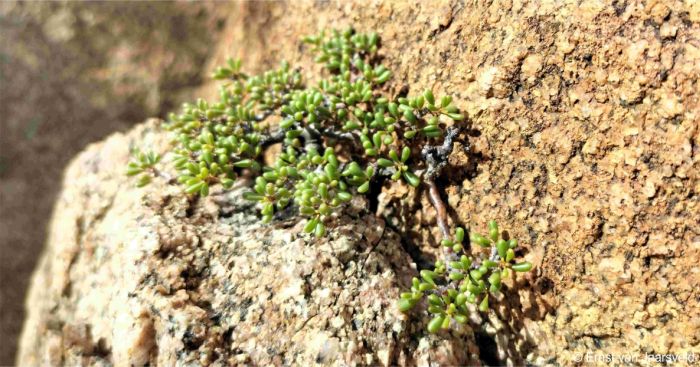
Fig. 8. A juvenile Portulacaria longipedunculata plant growing on the exposed western slope of a granite hill a few km west of Caranculo, southwestern Angola.
Propagation is from both cuttings and seed. Sow seed in summer or autumn in a sandy well-drained soil. The suggested mixture consist of 2 parts sand or gravel, 1 part loam, and 1 part compost. Cover the seed with a thin layer of sand (1-2 mm thickness). As a rule of thumb seed can be covered 2X the diameter of the seed. First moisten the medium and once sown the seed would stick to the substrate. Add the sand. Germination is within 3 weeks and once well rooted transfer to individual containers. These can be planted out as soon as they are big enough to handle.
References
- Bruyns, P., Oliveira-Neto, M., Melo-de-Pinna, G & Klak, C. 2014. Phylogenetic relationships in the Didiereaceae with special reference to subfamily Portulacarioideae. Taxon 63(5):1053–1064.
- Christenhusz, M.J.M., Fay, M.F. & Chase, M.W. 2017. Plants of the World, an illustrated Encyclopedia of vascular plants. Kew Publishing, Royal Botanic Gardens, Kew.
- Dyer. R.A. 1984. Ceraria namaquensis. Flowering Plants of Africa. 45: t. 1892.
- Eggli, U. (ed). 2001. Illustrated handbook of succulent plants: Dicotyledons. Springer, Berlin.
- Glen, H.F. & Germishuizen, G. (compilers). 2010. Botanical exploration of southern Africa, edition 2. Strelitzia 26. South African National Biodiversity Institute, Pretoria.
- Leistner, O. 2022. Early botanical exploration in the Kaokoveld (northwestern Namibia) 1957. SANBI Biodiversity Series 31. South African National Biodiversity Institute, Pretoria.
- Mannheimer, C.A. & Curtis, B.A. 2018. Le Roux and Müller’s field guide to the trees and shrubs of Namibia. Second edition. Namibia Publishing House, Windhoek.
- Merxmuller, H. & Podlech, D. 1961. Miscellanea. Portulacaceae, Ceraria longipedunculata. Mitteilungen der Botanischen Staatssammlung München 4: 73-74.
- Pearson, H.H.W. & Stephens, E.L. 1912. List of the plants collected in the Percy Sladen Memorial Expeditions, 1908-9, 1910-11: Portulacaceae. Annals of the South African Museum 9:30-35.
- Podlech, D. 1969. Portulacacaeae pp. 1–12 in H. Merxmüller (ed.), Prodromus einer Flora von Südwestafrika. Cramer, Lehre.
- Rowley, G.D. 2002. Ceraria pp. 379–380. In U. Eggli, (Ed) Illustrated handbook of succulent plants: dicotyledons. Springer-Verlag, Berlin.
- Smith, C.A. 1966. Common names of South African plants. Memoirs of the Botanical Survey of South Africa No. 35. Government Printer, Pretoria.
- Swanepoel. 2007. Didiereaceae/Portulacaceae. Ceraria kaokoensis, a new species from Namibia, with notes on gynodioecy in the genus. Bothalia 37(2): 202.
- Van Jaarsveld, E.J. 2010. Waterwise gardening in South Africa and Namibia. Struik, Cape Town.
Credits
Ernst van Jaarsveld
Kirstenbosch National Botanical Garden (Retired)
Babylonstoren Farm (Current)
Extraordinary senior lecturer and researcher,
Department of Biodiversity and Conservation, University of the Western Cape
April 2024
Plant Attributes:
Plant Type: Shrub, Succulent
SA Distribution:
Soil type: Sandy, Loam
Flowering season: Spring, Early Summer, Late Summer
PH: Acid, Neutral
Flower colour: Pink
Aspect: Full Sun
Gardening skill: Challenging
Special Features:
Horticultural zones








Rate this article
Article well written and informative
Rate this plant
Is this an interesting plant?
Login to add your Comment
Back to topNot registered yet? Click here to register.